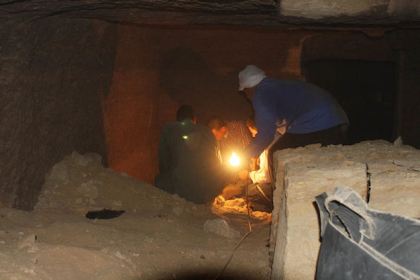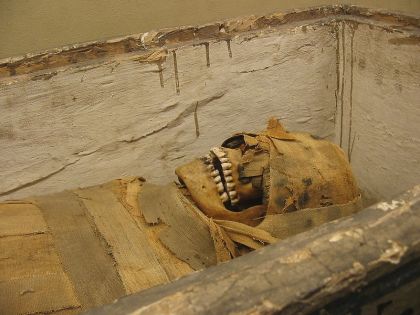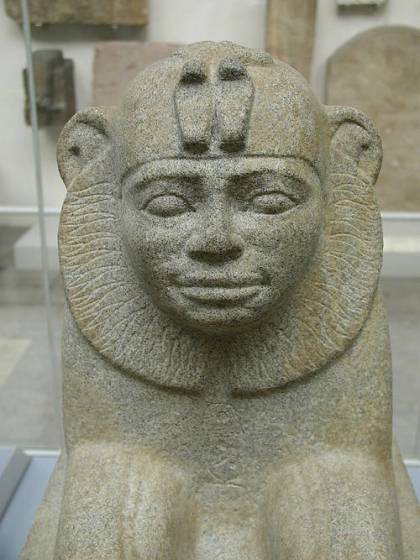An ongoing dig along the Red Sea in Egypt has revealed remnants of a largely undocumented aspect of ancient Egyptian culture: sea-faring.
Boston University archeologist Kathryn Bard and her colleagues are uncovering the oldest remnants of seagoing ships and other relics linked to exotic trade with a mysterious Red Sea realm called Punt.
“They were the space launches of their time,’’ Bard said of the epic missions to procure wondrous wares.
Although Nile River craft are well-known, the ability of ancient Egyptian mariners to ply hundreds of miles of open seas in cargo craft was not so fully documented.
More on the story here, plus an article from National Geographic that recounts a 2006 dig for ancient sea-going ships in the same area. [Image: National Geographic].
A set of tombs recently uncovered near the great pyramids of Giza show that free workers, rather than slaves, were enlisted to build the pyramids. While this theory has already been prominent among Egyptologists for some time, it nonetheless remains difficult to imagine hundreds of thousands of people dragging 2.3 million stone blocks (the largest of which weighed 80 tons) for any other reason than slavery. Perhaps these recently found tombs were supervisors of legions of slaves. Ultimately, it depends on the leader. The pharaoh Khufu may have been powerful and beloved enough that his people would have gone to any length to erect this monument in his name. This level of power, though, is difficult for the modern world to grasp.
“These tombs were built beside the king’s pyramid, which indicates that these people were not by any means slaves,” Zahi Hawass, the chief archaeologist heading the Egyptian excavation team, said in a statement.
“If they were slaves, they would not have been able to build their tombs beside their king’s.”
He said the collection of workers’ tombs, some of which were found in the 1990s, were among the most significant finds in the 20th and 21st centuries.
They belonged to workers who built the pyramids of Khufu and Khafre.
Mr Hawass had earlier found graffiti on the walls from workers calling themselves “friends of Khufu” – another sign that they were not slaves.
More on the new tombs at Giza.
A new study shows that the extravagant eye make-up worn by ancient Egyptians had medicinal purposes.
The study, published in the journal Analytical Chemistry, suggests it helped to protect against eye disease.
The key appears to be lead salts contained in the make-up.
At very low levels, salts produce nitric oxide, which boosts the immune system to fight off bacteria which can cause eye infection.
The make-up used by the ancient Egyptians to darken and enhance the eyes sometimes took up to a month to concoct.
In theory, because it contained lead it might actually have posed a risk to health.
But an analysis by scientists from the Louvre Museum and the CNRS research institute found that in very low doses lead could actually have a positive effect.
Lead researcher Philippe Walter said: “We knew ancients Greeks and Romans too had noted the make-up had medicinal properties, but wanted to determine exactly how.”
More on the recent eye make-up study.
The two 2500-year-old tombs unearthed recently at Saqqara in Egypt, will shed light on the Egpytian middle class.
Dating from the 26th dynasty, which ruled Egypt from about 664 BC to 525 BC, the tombs were found near the entrance to the archaeological site at the Saqqara burial ground, 30 km (20 miles) south of Cairo.
“These tombs belonged to middle class Egyptian families, not royalty, and had no names on them. They were reused by many people and can give us lots of information on burial customs and religion at the time,” Zahi Hawass, Egypt’s head of antiquities who led the all-Egyptian archaeological team, told Reuters.
A 2,500-year-old tomb recently unearthed at Saqqara in Egypt is the largest recorded tomb in the necropolis.
Egyptian archaeologists have unearthed the largest tomb yet discovered in the ancient Saqqara necropolis, antiquities chief Zahi Hawass said on Monday.
One of two tombs found, which were carved out of stone, consists of a vast chamber that branches off into many alcoves. One alcove contained skeletons and pottery, and led to another chamber with a seven-metre-deep (23-foot) well.
“This is the largest tomb in Saqarra,” Hawass told AFP. “It took me two hours to look round all of it.”
At the northern end of the tomb, Hawass said archaeologists found another alcove that contained mummified falcons — symbols of the sky god Horus — and well-preserved pottery.
However, he said the tomb did appear to have been looted.
Pottery was found in the other, much smaller, tomb.
“This discovery… confirms that the Saqqara area still contains undiscovered secrets,” Hawass said.
More on the latest discovery at Saqqara.
A Worcester, MA librarian can prove that American paper manufacturers in the 1800s made paper from the wrappings of ancient Egpytian mummies.
Egyptian mummies were imported to America with great fanfare in the early to mid-1800s. They were paraded around at carnivals and exhibitions, announced with blaring newspaper headlines and in gaudy advertisements. People paid up to 25 cents — a huge amount of money in those days — just to see one.
When Ms. Wolfe started the project, experts told her she should expect to find about 350 mummies in the U.S. She has tracked down 560, she said, although some of them “have been reduced to hands, feet and heads.” …
The idea of using mummy wrappings to make paper might sound ridiculous to modern ears, but before paper manufacturers began using wood pulp to make paper in the late 1850s, paper was manufactured exclusively from rags. (Fine paper today — like dollar bills and fine writing paper — is still made from cotton and linen rags, Ms. Wolfe said.)…
Rags from Egypt were plentiful in the 1800s, as it was not just pharaohs who were mummified. Thousands upon thousands of ancient Egyptians were mummified upon their deaths. And modern Egyptians in the 1800s, even as late as 1880, had a thriving tomb-raiding business that involved unwrapping the mummies to find any valuables, then selling the rags and even grinding up the bodies for fertilizer….
An American expedition in Sudan has found a one-ton statue of the Egyptian pharaoh, Taharqa.
Taharqa was a pharaoh of the 25th dynasty of Egypt. This was a period of Kushite rule, which means that Taharqa and his fellow rulers were from Nubia and drew their power-base from there.
In addition to Taharqa, archaeologists have found statues of two other Napatan kings at the site – Senkamanisken and Aspelta, neither of whom controlled Egypt…
In her blog Dr Rocheleau describes the Taharqa statue as, “more than life-size and weighs over one ton.”
The Taharqa and Senkamanisken statues have “great muscular bodies with an inscribed back pillar… and lovely feet on the statue base, but we are missing their heads and their lower legs.”









